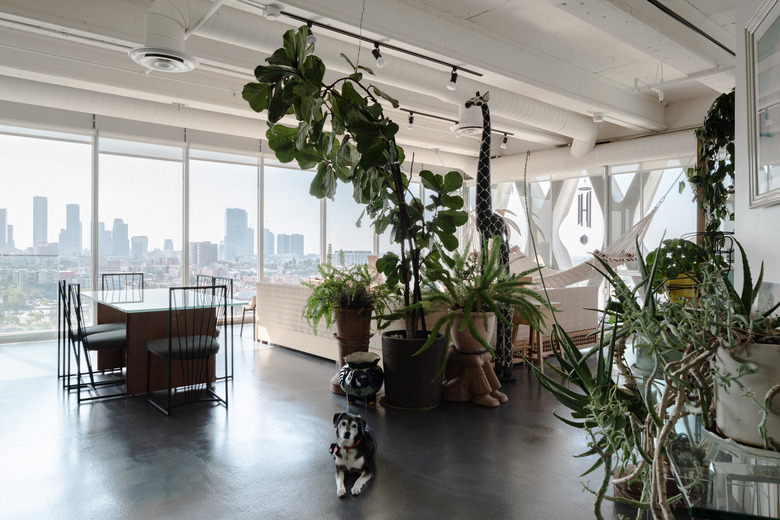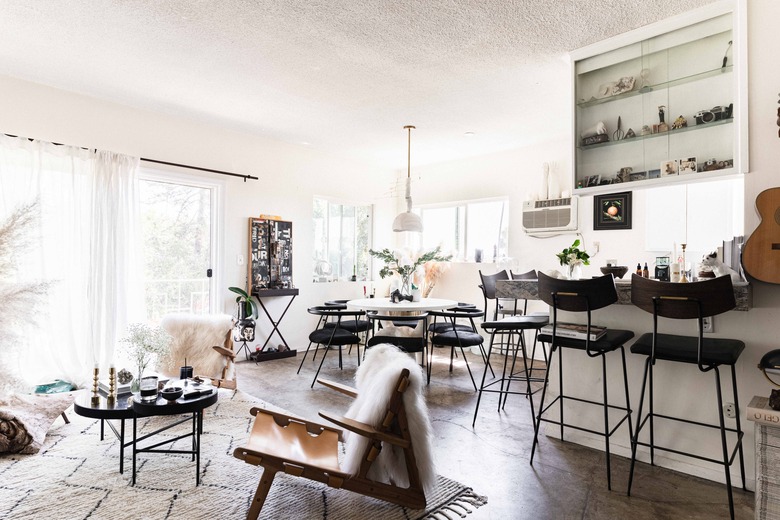Concrete Dye: A Homeowner's Guide
If you have a concrete surface either outside or inside your home that you want to spruce up with some color, concrete dye can be a great option for a number of reasons. Concrete dye can also be used in conjunction with concrete stains, and the two are often used together to create an element of depth and design that isn't easily achieved when used on their own. Finding the right product, application method and effect will depend on a few things, including the location of your concrete surface and the purpose for which it will be used.
What Is Concrete Dye?
What Is Concrete Dye?
Concrete dye is a coloring agent made up of fine color pigments that alters the look of concrete by penetrating the surface. Therefore, dying your concrete will not produce a chemical reaction to alter the look of your surface, so the color you see in the can is what you're going to get as a finished product. If you wish to alter the color of your dye, you can either add multiple layers, mix dye colors or dilute your dye to achieve a less-rich pigment.
Concrete dye is often confused with concrete stain, but the two are not the same product at all and differ for a number of reasons. Concrete dye products are found in two types, either a water-based or solvent-based product, while concrete stain is acid based. Generally, solvent-based dyes are formulated with acetone and mixed with powdered dye pigment at home once you're ready to get to work, and it produces a more even, flat coverage. Water-based dye is sold as a premixed liquid formula and is ready to apply right away. It is ideal for creating looks similar to stained effects, like marbling.
For a more translucent coverage of your concrete space, concrete stain may be a better bet than concrete dye. Unlike dye, which alters the color of concrete by penetrating the porous surface, stains change the color by reacting with alkalis in the surface of the concrete. Stains can also be more practical than dye if you're looking to renovate outdoor spaces. They are resistant to UV rays, so they won't fade nearly as quickly as dye would. Like dye, concrete stain should be sealed as a final application step.
When Is It Used?
When Is It Used?
Concrete dye is often used to add vivid, dark or deep colors to a surface. Oftentimes, it's used in addition to stain to add more color variance in certain design elements, like borders or tile patterns. Sometimes, dye can be used on top of stain to add more depth or vibrance. Because dye requires a porous surface for optimal color payoff, it's very important that your concrete floors are clean and free of any residue or buildup like gum or oil that may prevent dye from seeping into the concrete.
Concrete dye can be applied several ways, including spraying, rolling, using a brush and using a sponge. The first two ways are good options for larger areas like outdoor patios or basement floors, while the last two would be more efficient when used in a smaller area or to add detail to your floor's surface. Dye can only be applied to unsealed surfaces, so if you're looking to refinish your already-dyed concrete floors, you will need to use a concrete hand or push grinder or hire a professional to remove your sealant before you get to work.
Pros and Cons
Pros and Cons
One of the pros of using a dye on your concrete surface is that the color payoff is much more vibrant than it would be when using a stain. Additionally, there are way more colors from which to choose when selecting a dye — most stains are offered in earth tones along with a few soft, muted shades like light blue or light green. Dyes are able to be mixed together or diluted, opening up your color choices to essentially limitless possibilities, which can be especially helpful when dying interior concrete spaces.
Another great thing about working with dye is that it absorbs into concrete surfaces extremely quickly, which can cut your application time in half when compared to using stains or paints. Unlike paint, it penetrates into the surface to which it's being applied, which can make cleanup quicker and easier as well. Concrete dyes also contain zero or low levels of volatile organic compounds (VOCs). According to the Environmental Protection Agency, VOCs have been linked to serious health issues, including liver damage and cancer, and can seriously impact the air quality in indoor spaces.
On the other hand, there are some downsides to using dye on concrete. The main one is that it is not UV stable, meaning it will fade under the light of the sun, sometimes in as little as a few months. One way around this unfortunate trait is to only use concrete dye indoors where sun exposure is less intense. Additionally, solvent-based dyes made from materials like acetone are incredibly flammable, which can make the application process dangerous if you aren't careful. If you are looking to apply solvent-based dye to your concrete floors, make sure your area is free of flames, sparks and ignitors and is well ventilated at all times.
How to Apply Concrete Dye
How to Apply Concrete Dye
Concrete dye can make a great DIY home renovation project because the materials needed are few, and the skill level required to execute such a job is fairly low. When applying a water-based dye, do your best to not allow your liquid to pool, as it does evaporate slowly, and this can affect the finished look. Alternatively, solvent-based dyes evaporate much quicker, so be sure to use a light hand during application in case of mistakes.
Adding a sealant to your floor is highly recommended, especially on outdoor surfaces since it will protect the surface from damage and fading.
- Prep your area by sweeping away any dirt and debris with a broom or vacuum and mop the area with clean water. Allow the surface to dry completely.
- Follow the mixing directions for your dye, which can be found on the container in which it came, and place the dye in a bucket. Then, put on some protective clothing like rubber gloves, goggles and old shoes and pants you don't mind getting dirty.
- Apply the dye using your preferred method: sprayer or roller. If you're using a sprayer, use circular motions and take care to keep your sprayer about 2 feet from the floor. If you're rolling, use an arching movement to apply your dye and take extra care to wipe up any droplets that may drip from the roller to the floor, as these can leave marks if they aren't rolled in right away.
- Wait 15 minutes for the dye to absorb into the concrete surface and dry. Then, apply a second coat if you wish. Adding another layer of dye will make your color a bit darker. Always wait 15 to 20 minutes between applications before adding another layer.
- Switch your spray nozzle to one designed for applying sealant and apply your sealant the same way you applied your dye — in circular motions and a safe distance from the ground. You can also use a roller to apply your sealant.
- Allow your newly dyed and sealed surface to dry for several hours. Most sealants will be dry to the touch in about three hours, although you should wait between 24 and 48 hours before walking on it or using it as you usually would.


